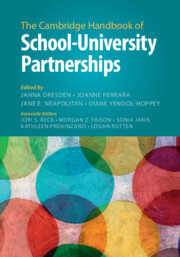Book contents
- The Cambridge Handbook of School–University Partnerships
- The Cambridge Handbook of School–University Partnerships
- Copyright page
- Contents
- Figures
- Tables
- Contributors
- Foreword
- Preface
- Acknowledgments
- Part I The History and Conceptual Foundations of School–University Partnerships
- Part II Teachers and Learning to Teach in School–University Partnerships
- Part III Equity and Student Learning in School–University Partnerships
- Part IV Leadership in School–University Partnerships
- Part V Community Schools as School–University Partnerships
- Part VI Inquiry and Innovation in School–University Partnerships
- Part VII Funding, Policy, and the Politics of School–University Partnerships
- Part VIII Looking at School–University Partnerships across Geographic and Cultural Borders
- Introduction to Part VIII: Looking at School–University Partnerships across Geographic and Cultural Borders
- 49 Australian School–University Partnerships
- 50 Research-Informed Clinical Practice in School–University Partnerships
- 51 Demarginalizing Culturally Responsive Pedagogy
- 52 Global Perspectives on School–University Partnerships
- 53 Global Perspectives on School–University Partnerships Between and Within Countries
- 54 Commentary: A Comparative and International Perspective on School–University Partnerships
- Index
- References
51 - Demarginalizing Culturally Responsive Pedagogy
A Hawaiʻi School–University Partnership Aimed at Promoting Teacher Candidates’ Abilities to Work with Micronesian Islanders
from Part VIII - Looking at School–University Partnerships across Geographic and Cultural Borders
Published online by Cambridge University Press: 05 November 2025
- The Cambridge Handbook of School–University Partnerships
- The Cambridge Handbook of School–University Partnerships
- Copyright page
- Contents
- Figures
- Tables
- Contributors
- Foreword
- Preface
- Acknowledgments
- Part I The History and Conceptual Foundations of School–University Partnerships
- Part II Teachers and Learning to Teach in School–University Partnerships
- Part III Equity and Student Learning in School–University Partnerships
- Part IV Leadership in School–University Partnerships
- Part V Community Schools as School–University Partnerships
- Part VI Inquiry and Innovation in School–University Partnerships
- Part VII Funding, Policy, and the Politics of School–University Partnerships
- Part VIII Looking at School–University Partnerships across Geographic and Cultural Borders
- Introduction to Part VIII: Looking at School–University Partnerships across Geographic and Cultural Borders
- 49 Australian School–University Partnerships
- 50 Research-Informed Clinical Practice in School–University Partnerships
- 51 Demarginalizing Culturally Responsive Pedagogy
- 52 Global Perspectives on School–University Partnerships
- 53 Global Perspectives on School–University Partnerships Between and Within Countries
- 54 Commentary: A Comparative and International Perspective on School–University Partnerships
- Index
- References
Summary
There is a need for culturally responsive pedagogy in school–university partnerships to prepare teachers for working with Micronesian Islanders in the state of Hawai’i. As United States public schools become more culturally diverse, there is a need for teacher education programs to better prepare candidates for working with demographically diverse students. Situated in the Hawai’i public school context, we explain how teacher preparation programs may better prepare teacher candidates for working effectively with culturally and linguistically diverse students. An empirical study details how the literature informed our efforts as teacher educators to promote teacher candidates’ understandings of culturally responsive pedagogy to work effectively with Micronesian Islanders; a historically marginalized student population in Hawaii’s public schools. The chapter concludes with suggestions for research, practice, and policy surrounding increased the use of culturally responsive pedagogy in school–university partnerships to prepare teacher candidates for working with historically marginalized student populations.
Keywords
Information
- Type
- Chapter
- Information
- The Cambridge Handbook of School–University Partnerships , pp. 823 - 849Publisher: Cambridge University PressPrint publication year: 2025
References
Accessibility standard: WCAG 2.1 AA
Why this information is here
This section outlines the accessibility features of this content - including support for screen readers, full keyboard navigation and high-contrast display options. This may not be relevant for you.Accessibility Information
Content Navigation
Allows you to navigate directly to chapters, sections, or non‐text items through a linked table of contents, reducing the need for extensive scrolling.
Provides an interactive index, letting you go straight to where a term or subject appears in the text without manual searching.
Reading Order & Textual Equivalents
You will encounter all content (including footnotes, captions, etc.) in a clear, sequential flow, making it easier to follow with assistive tools like screen readers.
Visual Accessibility
You will still understand key ideas or prompts without relying solely on colour, which is especially helpful if you have colour vision deficiencies.
Structural and Technical Features
You gain clarity from ARIA (Accessible Rich Internet Applications) roles and attributes, as they help assistive technologies interpret how each part of the content functions.
